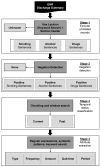Automated Detection of Substance-Use Status and Related Information from Clinical Text
- PMID: 36559979
- PMCID: PMC9783118
- DOI: 10.3390/s22249609
Automated Detection of Substance-Use Status and Related Information from Clinical Text
Abstract
This study aims to develop and evaluate an automated system for extracting information related to patient substance use (smoking, alcohol, and drugs) from unstructured clinical text (medical discharge records). The authors propose a four-stage system for the extraction of the substance-use status and related attributes (type, frequency, amount, quit-time, and period). The first stage uses a keyword search technique to detect sentences related to substance use and to exclude unrelated records. In the second stage, an extension of the NegEx negation detection algorithm is developed and employed for detecting the negated records. The third stage involves identifying the temporal status of the substance use by applying windowing and chunking methodologies. Finally, in the fourth stage, regular expressions, syntactic patterns, and keyword search techniques are used in order to extract the substance-use attributes. The proposed system achieves an F1-score of up to 0.99 for identifying substance-use-related records, 0.98 for detecting the negation status, and 0.94 for identifying temporal status. Moreover, F1-scores of up to 0.98, 0.98, 1.00, 0.92, and 0.98 are achieved for the extraction of the amount, frequency, type, quit-time, and period attributes, respectively. Natural Language Processing (NLP) and rule-based techniques are employed efficiently for extracting substance-use status and attributes, with the proposed system being able to detect substance-use status and attributes over both sentence-level and document-level data. Results show that the proposed system outperforms the compared state-of-the-art substance-use identification system on an unseen dataset, demonstrating its generalisability.
Keywords: electronic health records; information extraction; machine learning; natural language processing; rule-based systems; substance use.
Conflict of interest statement
The authors declare no conflict of interest.
Figures


Similar articles
-
Negation recognition in clinical natural language processing using a combination of the NegEx algorithm and a convolutional neural network.BMC Med Inform Decis Mak. 2023 Oct 13;23(1):216. doi: 10.1186/s12911-023-02301-5. BMC Med Inform Decis Mak. 2023. PMID: 37833661 Free PMC article.
-
DEEPEN: A negation detection system for clinical text incorporating dependency relation into NegEx.J Biomed Inform. 2015 Apr;54:213-9. doi: 10.1016/j.jbi.2015.02.010. Epub 2015 Mar 16. J Biomed Inform. 2015. PMID: 25791500 Free PMC article.
-
Natural language processing and machine learning to enable automatic extraction and classification of patients' smoking status from electronic medical records.Ups J Med Sci. 2020 Nov;125(4):316-324. doi: 10.1080/03009734.2020.1792010. Epub 2020 Jul 22. Ups J Med Sci. 2020. PMID: 32696698 Free PMC article.
-
Extracting social determinants of health from electronic health records using natural language processing: a systematic review.J Am Med Inform Assoc. 2021 Nov 25;28(12):2716-2727. doi: 10.1093/jamia/ocab170. J Am Med Inform Assoc. 2021. PMID: 34613399 Free PMC article.
-
Natural language processing of symptoms documented in free-text narratives of electronic health records: a systematic review.J Am Med Inform Assoc. 2019 Apr 1;26(4):364-379. doi: 10.1093/jamia/ocy173. J Am Med Inform Assoc. 2019. PMID: 30726935 Free PMC article.
References
-
- Centers for Disease Control and Prevention (CDC) Unintentional Drug Poisoning in the United States. [(accessed on 20 October 2021)]; Available online: https://www.cdc.gov/medicationsafety/pdfs/cdc_5538_ds1.pdf.
-
- World Health Organization and Research for International Tobacco Control . WHO Report on the Global Tobacco Epidemic, 2008: The MPOWER Package. World Health Organization; Geneva, Switzerland: 2008.
-
- Müller D., Koch R., Von Specht H., Völker W., Münch E. Neurophysiologic findings in chronic alcohol abuse. Psychiatr. Neurol. Und Med. Psychol. 1985;37:129–132. - PubMed
MeSH terms
LinkOut - more resources
Full Text Sources
Medical

